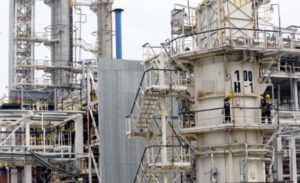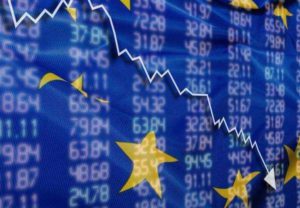Anatomy of decline: steady downfall of European industry
Deindustrialization is not a new word in economic policy, it was used to describe the transition in the world economy caused by crises in the 1970s and 1980s, often associated with the names of Ronald Raegan and Margaret Thatcher. Their legislation was also behind the change from industrial society to post-industrialism with greater use of information and new technologies, leading to a shift in production to less developed countries. But why are we seeing and hearing many more reports and articles about deindustrialization in Europe in the last three years?

Over the past decades, industrial production in Europe has been an important part of the European economy, and this continues to be the case. About one-sixth of the EU’s gross value added (GVA) was generated in manufacturing in 2021. But the share of industrial GVA in Europe’s major industrialised nations has been shrinking since then, with a more pronounced decline compared to the beginning of the century.
Over the course of the century, France has lost about 6% of the industrial share of its GVA. This is also the case for Italy and Germany, where industrial production peaked in 2017 and has been in steady decline since then, accelerating after 2022.
Why is the overall decline in European industrial production a cautionary reality that has many experts and politicians sounding the alarm?
There are a number of factors that are slowing down European production and making it difficult to compete with other investment destinations, notably China and the US.
The Russia-Ukraine conflict, which has been ongoing since February 2022, has had a significant impact on European energy prices and supply chains, leading to higher input costs for European industry and weaker demand from European consumers.
In 2021, Russia was the main exporter of oil, gasoline and gas to Europe, supplying 21% of European oil and gasoline imports and 23% of natural gas imports. Since then, there has been a sharp decline in gas supplies, mainly due to the explosion of the Nordstream pipelines and the US and EU sanctions against Russia, which led to an acute energy crisis.
The current gas and energy crisis is hitting industry particularly hard, as this sector of the economy is one of the largest energy consumers along with transport. The chemical and metal industries are most affected by this crisis due to high energy consumption.
Europe is trying to adapt to the use of LNG from the USA, which is more expensive than Russian gas and more difficult to supply, so that increases costs even further. In addition, often populist “green” restrictions in Europe are forcing manufacturers to spend more money on introducing new “environmentally friendly” technologies.
Another factor hindering European manufacturing growth is labour costs, which are traditionally higher than in China, where average workers’ wages are still significantly lower than in the West, despite the steady increase in educational levels in recent years.
In other Asian countries such as India, Vietnam or Thailand, labour costs are even lower than in China. In the United States, on the other hand, labour costs are slightly higher than the European Union average, but are still lower than in Germany or France and about the same as in Italy. This is mainly because in the EU, in addition to countries with high labour costs such as Germany and France, there are also countries with lower wages such as Spain or Eastern European states.
The disruption of usual supply chains due to the situation in the Red Sea, where Yemeni Houthis are attacking foreign ships, is one of the recent factors that has impacted the European manufacturing sector. The rerouting of ships increased the delivery time between Asia and the EU by 10-15 days and costs increased by about 400%.

All these factors make it difficult for European states to compete with China, the US and Southeast Asian states in terms of attractiveness for industrial production.
In addition, the tension between the EU and the US intensified after Joe Biden signed the Inflation Reduction Act in August 2022, which aims to transition American industry to “green” tracks and gives US-based companies some privileges, making the move to America even more attractive for manufacturers. At the same time, the situation on the European market is also worsened by the fact that European manufacturers are forced to compete with cheaper Chinese and American products.
So what real signs of European deindustrialization can we observe? Some are a reduction in expansion plans and investments. Other signs of deindustrialization are more obvious, such as the relocation of production lines and the reduction of materials.
For example, German chemical giant BASF announced the closure of one of its two ammonia production plants in Germany and also decided to shut down its fertilizer production plants. These steps resulted in the elimination of 2,500 jobs. In February, BASF announced further austerity measures.
Swiss solar module maker Meyer Burger Technology AG announced in February 2024 that it would cease production of solar modules in Freiburg, Germany. The company decided to focus on increasing production capacity in the United States, citing deteriorating market conditions in Europe.
Germany’s BMW Group announced in 2022 that it plans to invest $1.7 billion in electric vehicle and battery production in the United States. Volkswagen has also decided to take advantage of the incentives for electric car manufacturers in America and build a $2 billion plant in South Carolina to produce electric SUVs. The BMW Group also expanded its presence in China in 2022 by starting production of electric vehicles at the new Lydia plant in Shenyang, Liaoning province in the northeast of the country. This project, worth 15 billion yuan ($2.1 billion), is BMW’s most significant investment in the Chinese market.
In conclusion, European industry is in a very difficult situation today due to the ongoing energy crisis and increasing competition from the US and China. Further deindustrialisation will put at risk the prosperity and jobs of 32 million people in Europe, along with many others who work in various industrial sectors.
Nevertheless, Europe has many advantages as an industrial location, such as a high quality of labour, a high density of companies and the resulting short distances between companies and their suppliers. In addition, Europe remains an important and prosperous sales market in many sectors.
The question is, then, whether European politicians will be able to shift their strategy and focus on saving their own production without looking back at the US, which is profiting from the plight of its ally.
yogaesoteric
September 26, 2024
